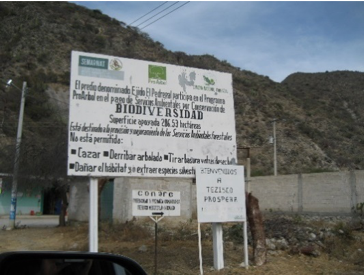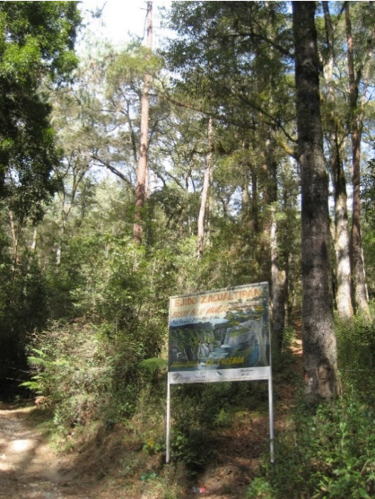Paying communities to conserve and manage their jointly owned property doesn’t just benefit the environment—it strengthens social relationships and a sense of community within those areas as well, according to new research led Katharine Sims, associate professor of economics, in collaboration with Jennifer Alix-Garcia, professor of applied economics at Oregon State University. The economists’ findings provide new evidence that payments for environmental services can provide broader social benefits.
A paper about the work, titled “Payments for environmental services supported social capital while increasing land management,” was published by Proceedings of the National Academy of Sciences was posted online on June 14. Other study collaborators include researchers with the World Bank’s Development Research Group and the Evaluation Department of the Mexican National Forestry Commission.

A community in Hidalgo State, Mexico, clears vegetation from a firebreak as part of a payments for environmental services program. Photo by the Mexican National Forestry Commission.
Previous research by Sims and Alix-Garcia was among the first to show that payments for environmental services could slow deforestation, especially when contracts were targeted to communities under strong pressure to convert natural lands into cropland or pasture. This latest study found further evidence that incentive-based conservation initiatives, as they are called, result in increased land management activities, such as patrolling for illegal activity, building fire breaks and controlling pests.
Most importantly, the findings of the study show that such payment programs also improve participants’ “social capital”: involvement in assemblies, ability to resolve conflicts, trust between members and community-building efforts, among other skills. The research is the first to analyze the “social capital” impacts of a national-scale, globally relevant program.
“Conservation of natural resources often relies on voluntary contributions of time and effort, and payments for environmental services policies boost these efforts by providing funding for maintenance of forests and other natural vegetation,” said Sims, adding that incentive-based conservation programs have been adopted in multiple countries and play a central role in global climate agreements. “While these financial incentives help forest management activities compete with other land uses, many conservationists worry that external payments will undermine moral or intrinsic motivation to protect nature. Added Alix-Garcia: “Our work shows that the program did not crowd out unpaid contributions to land management or other voluntary community work, which is noteworthy.”

A sign tells visitors in Spanish that this community participates in the Payments for Ecosystems Service Program for biodiversity conservation. Hunting, cutting down vegetation, littering or extracting wildlife are prohibited. Photo by Katharine Sims, Amherst College.
The team’s work was conducted in megadiverse Mexico, the perfect living laboratory for the team, as it contains more than 10 percent of the world’s biodiversity and between 50 and 60 percent of the world’s known plant species. The study focused on the country’s agrarian communities, which are formally recognized structures of local governance that make joint decisions on land management through elected councils and an assembly of members. Approximately half of forested land in Mexico is governed under these arrangements, making them key to the future of biodiversity and watershed protection. At least 18 percent of global land is controlled communally.
Mexico’s federal Payments for Environmental Services (PES) program, run by the Mexican National Forestry Commission, funds conservation activities by landowners. It provides five-year contracts to selected participants who agree to maintain existing forest or other natural vegetation and manage their land according to a voluntary plan. Participants in the PES receive annual payments equivalent to approximately $8 to $32 U.S. dollars per acre ($12 on average) and are monitored by field visits and satellite.
To evaluate the PES’ social impacts, Sims and Alix-Garcia used a method called regression discontinuity, which took advantage of the fact that the program had many more applicants than the available budget to support them, in order to make a comparison between participants and similarly rejected applicants. Participants were selected on the basis of points that rank their risk of deforestation and ecological and social characteristics, with the highest ranking participants in each state accepted to the program. By comparing the outcomes for applicants above and below the cutoffs, researchers could isolate the impact of the program from other possible confounders. Sims and Alix-Garcia designed and supervised the collection of information from more than 800 leaders of agrarian communities and 8,000 individual households via field-based surveys.

A sign tells visitors in Spanish that this ejido’s forest is under management to protect the watershed. Photo by Katharine Sims, Amherst College.
The team found that payments increased land management activities by more than 50 percent among participants compared to similar controls. The program had a statistically significant, 8 to 9 percent impact on community social capital.
“Social capital and trust are understood to be important drivers of economic development generally and of collective action to protect the environment,” said Alix-Garcia. “We were really encouraged to see that Mexico’s PES is supporting pro-social behavior in addition to directly incentivizing conservation. We are very interested to see how PES may impact social capital in other settings globally.”